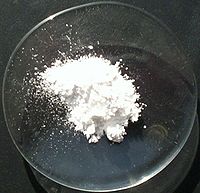
Photo from wikipedia
Variation in temperature during synthesis is a favorite aspect to get enhanced structural, optical, magnetic, and catalytic properties. Here, in this work, Spinel (CuFe2O4) ferrites were formulated with various calcination… Click to show full abstract
Variation in temperature during synthesis is a favorite aspect to get enhanced structural, optical, magnetic, and catalytic properties. Here, in this work, Spinel (CuFe2O4) ferrites were formulated with various calcination temperatures. The method used is a simple, economical, and eco-friendly microwave combustion method. Impact of annealing temperature on structural analysis is confirmed by XRD analysis. Under the following parameters, the structural changes are discussed: diametrical size, lattice parameter, strain, tetrahedral and octahedral hopping length, and bond length, respectively. HR-TEM results assure the spherical-shaped morphology. The average diametrical size calculated is in good agreement with the XRD results. The EDAX spectrum confirms the composition of sample and its purity. A FT-IR study exemplifies the ferrite characteristic peaks available as synthesized sample. The UV–Vis analysis and Tauc’s plot of the samples give us the optical bandgaps as 2.2, 2.1, and 2.08 eV, respectively. An increase in calcination temperature exhibits an enhancement in saturation magnetization (Ms), remnant magnetization (Mr), and coercivity (Hc) at room temperature. Degradation activity of methylene blue (MB) studied by catalyst CuF-MW, CuF-500, and CuF-600 expresses the degradation efficiency of the catalyst. CuF-MW exhibits an excellent result than other samples, due to large surface area and the small diametrical size.
Journal Title: Journal of Materials Science: Materials in Electronics
Year Published: 2020
Link to full text (if available)
Share on Social Media: Sign Up to like & get
recommendations!